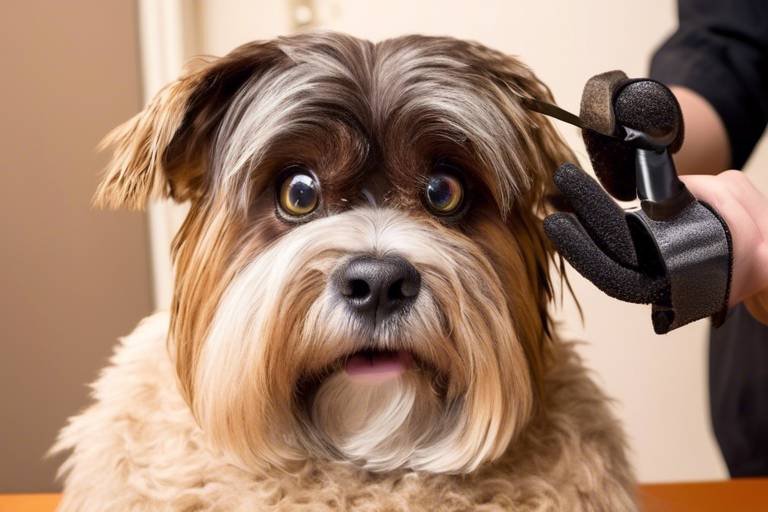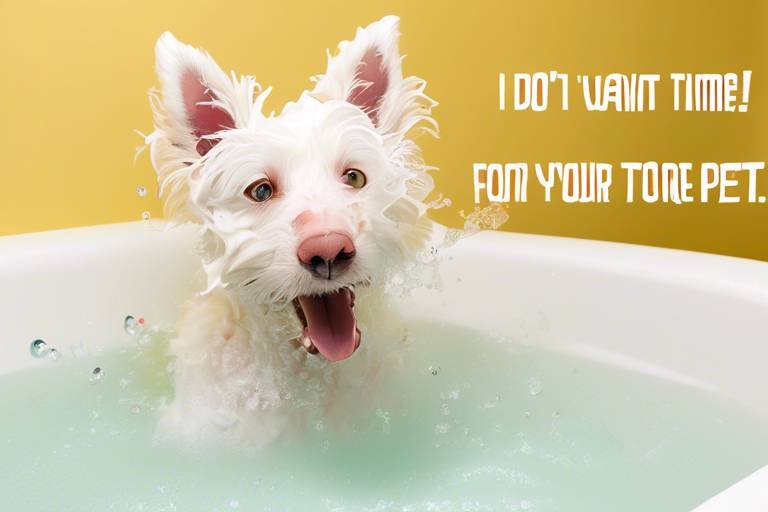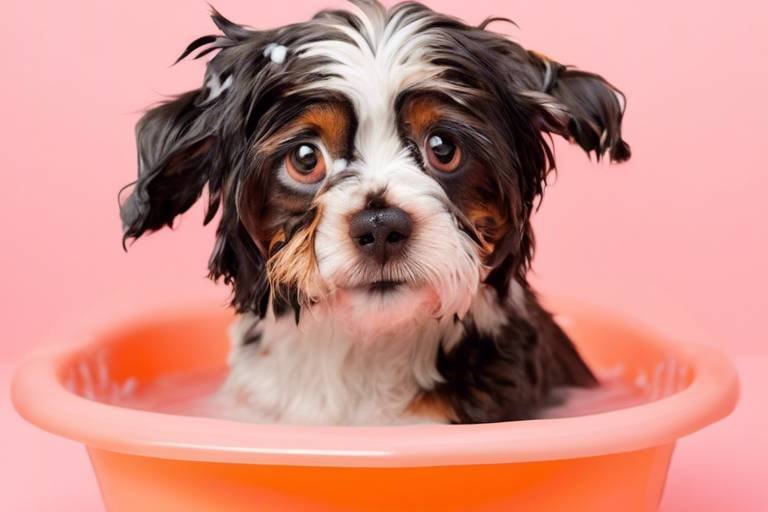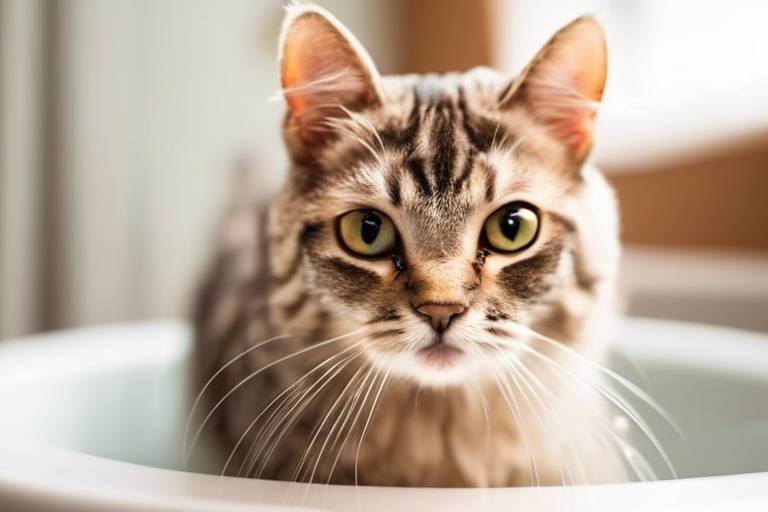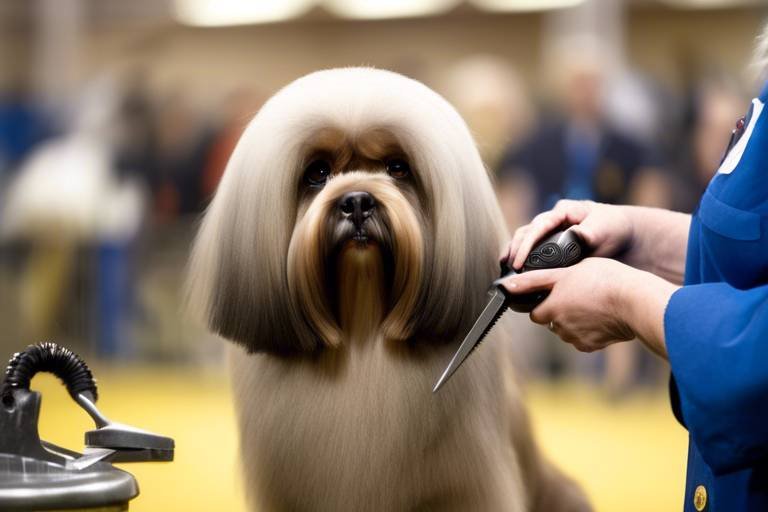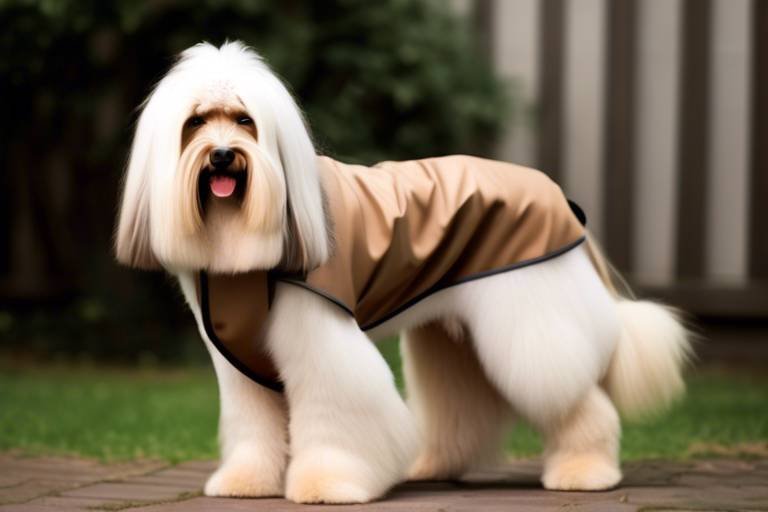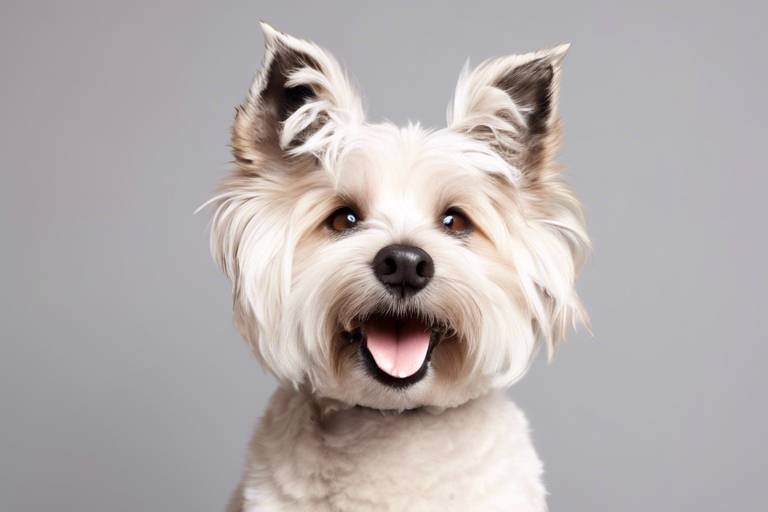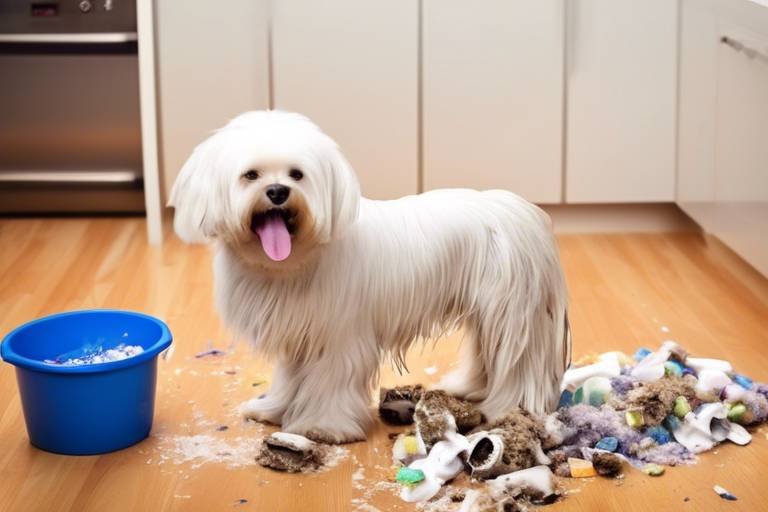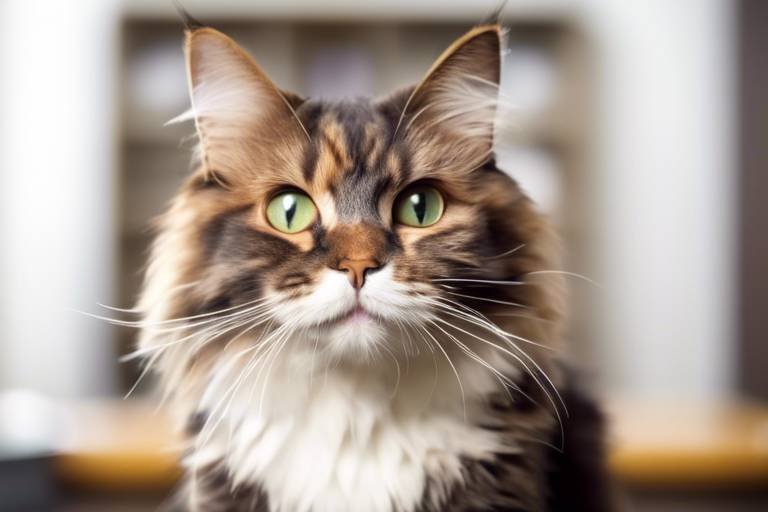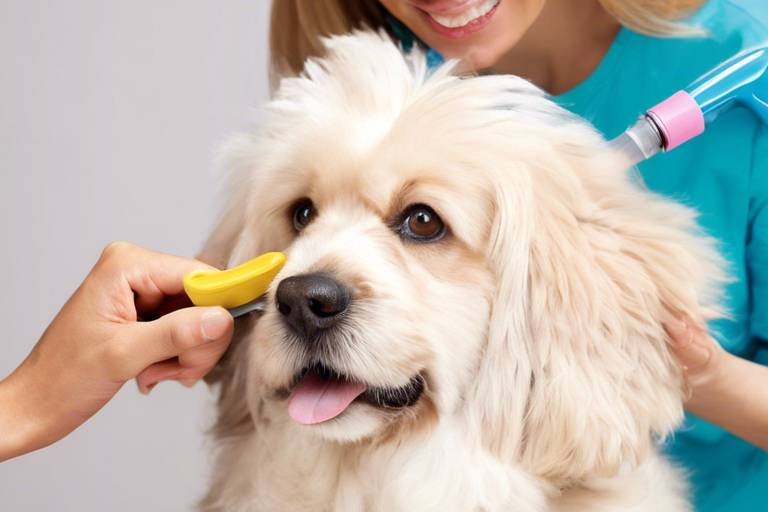How to Help Your Pet Adjust to New Grooming Techniques
Grooming your pet can sometimes feel like a daunting task, especially when introducing new techniques. But fear not! With a little patience and understanding, you can turn grooming into a bonding experience rather than a battle. The key is to approach the process with a positive attitude and a plan. Just like humans, pets have their own personalities and comfort levels, and recognizing these can make all the difference. Imagine trying on a new outfit that just doesn’t fit right; your pet may feel the same way about unfamiliar grooming methods. So, how do we bridge this gap and help our furry friends feel at ease? Let’s dive into some effective strategies that will not only make grooming easier but also create a more enjoyable experience for both you and your pet.
Before you even pick up a brush or clipper, it's crucial to understand your pet's behavior. Animals communicate a lot through their body language. For instance, if your dog tucks its tail or your cat flattens its ears, these are clear signs of discomfort. Observing these signals can help you gauge their comfort levels during grooming sessions. Think of it like reading a book; the more you understand the story, the easier it is to follow along. By tuning into your pet's reactions, you can adjust your techniques accordingly. This not only helps in reducing anxiety but also fosters a trusting relationship between you and your furry friend.
Just like a chef needs the right utensils to prepare a meal, you need the appropriate grooming tools to keep your pet looking their best. Selecting tools that cater to your pet's specific needs can significantly enhance the grooming process. Imagine trying to cut hair with a butter knife—frustrating, right? The same applies to grooming! Whether it’s a brush, comb, or clipper, using the right tool can make all the difference in ensuring a smooth grooming experience. So, let’s explore the different types of grooming tools available and how they can benefit your pet.
Familiarizing yourself with various grooming tools is essential. Here’s a quick overview of some common grooming tools and their uses:
| Tool | Use |
|---|---|
| Brush | Removing loose fur and preventing matting |
| Comb | Detangling and smoothing fur |
| Clippers | Trimming and cutting fur |
| Scissors | Precision cutting for specific areas |
It’s important to note that different coat types require specific brushes. For example, a slicker brush works wonders on long-haired breeds, while a bristle brush is perfect for short-haired pets. Understanding these differences helps ensure the grooming process is efficient and comfortable for your pet. Imagine trying to brush curly hair with a straightener; it just doesn’t work! The right brush can make grooming a breeze, reducing stress and discomfort for your furry friend.
When it comes to using clippers, safety is paramount. Improper handling can lead to injuries, causing your pet to associate grooming with fear. To avoid this, make sure to introduce the clippers slowly, allowing your pet to sniff and get accustomed to the sound before using them. Think of it like introducing a new toy; you wouldn’t just throw it at them, right? A gradual approach will help your pet feel secure during the grooming session.
Exploring various grooming techniques can help you find the best approach for your pet. Techniques such as desensitization—gradually exposing your pet to grooming tools—can significantly minimize anxiety. Additionally, keeping the sessions short and sweet initially can help your pet adjust without feeling overwhelmed. Remember, it’s all about making the experience as enjoyable as possible!
Creating a consistent grooming schedule can be a game-changer. Just like humans thrive on routine, so do pets. When grooming becomes a regular part of their life, they learn to anticipate and accept it. This predictability can ease anxiety and make each session smoother. Think of it as teaching them a new trick—practice makes perfect!
Determining how often to groom your pet depends on their breed, coat type, and individual needs. For instance, long-haired breeds may require more frequent grooming compared to short-haired ones. Pay attention to your pet’s coat condition and adjust the frequency accordingly. Too much grooming can lead to irritation, while too little can result in matting. Finding that sweet spot is key!
Lastly, don’t underestimate the power of positive reinforcement. Using treats and praise during grooming sessions can help build a positive association with the process. Every time your pet sits calmly or allows you to brush them without fussing, reward them! This not only encourages good behavior but also strengthens your bond. It's like giving a high-five for a job well done!
- How often should I groom my pet? It depends on their breed and coat type. Long-haired pets typically require more frequent grooming.
- What tools do I need for grooming? Basic tools include a brush, comb, and clippers. Choose based on your pet’s specific needs.
- How can I calm my pet during grooming? Use treats, praise, and a gentle approach to build a positive association with grooming.
- What if my pet doesn't like grooming? Take it slow and gradually introduce them to the tools and processes. Patience is key!

Understanding Your Pet's Behavior
When it comes to grooming your furry friend, understanding their behavior is absolutely crucial. Pets, just like humans, have their own unique ways of expressing comfort or discomfort. By paying close attention to their body language and reactions, you can tailor your grooming techniques to suit their needs, making the entire experience more enjoyable for both of you. Have you ever noticed how your dog’s ears perk up when they’re excited or how they might cower when they’re scared? These subtle cues can tell you a lot about how they’re feeling during grooming sessions.
For instance, if your pet is constantly trying to escape or hide, it might be a sign that they’re feeling anxious or threatened. On the other hand, if they’re relaxed, wagging their tail, or even leaning into the brush, it’s a clear indication that they’re comfortable and enjoying the attention. Recognizing these signs can transform grooming from a dreaded chore into a bonding experience. Keep an eye out for signs such as:
- Tail Position: A high, wagging tail typically indicates happiness, while a tucked tail suggests fear.
- Ears: Forward-facing ears indicate curiosity or excitement, while flattened ears can signify anxiety.
- Body Posture: A relaxed body posture shows comfort, whereas a stiff or crouched position may indicate stress.
Moreover, understanding your pet's behavior can help you identify specific triggers that may cause anxiety during grooming. For example, if your dog becomes anxious when you bring out the clippers, it might be beneficial to introduce the clippers gradually. Start by letting them sniff the clippers while rewarding them with treats, creating a positive association. This approach not only helps to reduce anxiety but also fosters trust between you and your pet.
Another important aspect to consider is the timing of your grooming sessions. Some pets may be more tolerant in the morning after a good night's sleep, while others might prefer a quieter time in the evening. Observing your pet’s energy levels and mood can help you choose the best time for grooming, ensuring a smoother experience. Remember, patience is key! If your pet shows signs of distress, take a break and try again later. This way, grooming can become a pleasant routine rather than a stressful event.
In summary, understanding your pet's behavior is all about being observant and responsive. By tuning into their body language and emotional state, you can make grooming a more enjoyable experience. After all, a happy pet means a happy owner!

Choosing the Right Tools
When it comes to grooming your beloved pet, choosing the right tools is absolutely crucial. The right tools can transform a potentially stressful experience into a delightful bonding moment. Imagine trying to chop vegetables with a butter knife—it just won’t work! Similarly, using inappropriate grooming tools can lead to discomfort for your furry friend and frustration for you. So, let’s dive into the world of grooming tools and discover what works best for your pet.
First off, it's important to recognize that not all pets are created equal. Different breeds and coat types require different grooming tools. For instance, a Golden Retriever with its thick, water-repellent coat needs a different brush than a Shih Tzu with its long, silky hair. Knowing your pet's specific grooming needs will help you select the most effective tools. Here’s a quick breakdown of some common grooming tools:
| Tool Type | Best For | Features |
|---|---|---|
| Brushes | All coat types | Variety of bristle types; helps remove loose fur and prevent mats. |
| Combs | Long-haired breeds | Great for detangling and smoothing fur; can reach deeper layers. |
| Clippers | Short-haired breeds | Efficient for trimming and maintaining coat length; requires safety precautions. |
| De-shedding Tools | Heavy shedders | Designed to remove undercoat; reduces shedding significantly. |
Now, let’s talk about brushes. Brushes come in various shapes and sizes, each designed for specific coat types. For example, a slicker brush is fantastic for removing mats and tangles in long-haired breeds, while a bristle brush works wonders for short-haired pets. Understanding the different types of brushes can significantly enhance your grooming sessions. You wouldn’t use a hammer to fix a watch, right? The same principle applies here—using the right brush can make all the difference.
When it comes to clippers, safety should always be your top priority. Improper use can lead to injuries, and we definitely don’t want that! Make sure to choose clippers that are specifically designed for pets, as they tend to be quieter and easier to handle. Always start with a lower guard to avoid cutting too close to the skin, and remember to keep your pet calm during the process. Think of it as a dance; you need to move in sync with your partner to avoid stepping on their toes!
Ultimately, the goal is to make grooming a positive experience for both you and your pet. By selecting the right tools, you not only ensure a more effective grooming session but also help your pet feel comfortable and secure. So, take the time to research and invest in quality grooming tools that cater to your pet’s unique needs. After all, your furry friend deserves the best!
Types of Grooming Tools
This article explores effective strategies to ease your pet into new grooming techniques, ensuring a comfortable and stress-free experience for both you and your furry friend.
Recognizing your pet's body language and reactions during grooming can help you identify their comfort levels and adjust your techniques accordingly for a more positive experience.
Selecting appropriate grooming tools tailored to your pet's specific needs can significantly enhance the grooming process, making it more enjoyable and effective for both you and your pet.
When it comes to grooming your beloved pet, choosing the right tools can make all the difference. Just like a painter needs the right brushes, you need to have the appropriate grooming tools to keep your furry friend looking their best. Here’s a rundown of the essential grooming tools that every pet owner should consider:
- Brushes: Brushes come in various shapes and sizes, tailored for different coat types. For instance, slicker brushes are fantastic for removing tangles and mats in long-haired breeds, while bristle brushes work wonders on short-haired pets, enhancing their natural shine.
- Combs: A good comb can be your best friend, especially for pets with thick or curly coats. Combing helps in untangling knots and can also be used to check for fleas or other skin issues.
- Clippers: If your pet requires a haircut, clippers are essential. They come in various sizes and types, so it’s crucial to select the right one for your pet's coat length and thickness.
- Scissors: For those finishing touches, a good pair of grooming scissors can help you trim around sensitive areas like the eyes and paws.
Understanding the specific grooming needs of your pet can help you select the right tools. For example, a golden retriever will have different grooming requirements compared to a poodle. Therefore, familiarizing yourself with the types of grooming tools available is key to ensuring a smooth grooming experience.
Different coat types require specific brushes. For example, if you have a long-haired breed, using a wide-toothed comb first can help detangle the hair, followed by a slicker brush to remove loose fur. On the other hand, a short-haired breed may only need a bristle brush to distribute natural oils and remove dirt. Understanding these differences helps ensure the grooming process is efficient and comfortable for your pet, reducing stress and discomfort.
When using clippers, safety is paramount. Always ensure that the clipper blades are sharp and clean to avoid pulling on your pet's hair. Start with a larger guard to get your pet used to the sound and sensation before moving to shorter cuts. Moreover, it’s essential to keep your pet calm and secure during the grooming session to prevent any accidents.
Exploring various grooming techniques can help you find the best approach for your pet, allowing for a smoother transition to new grooming methods while minimizing anxiety.
Creating a consistent grooming schedule helps your pet acclimate to new techniques over time, making each session easier and more predictable for both you and your furry companion.
Determining how often to groom your pet based on their breed, coat type, and individual needs ensures they receive the care they require without feeling overwhelmed.
Using treats and praise during grooming sessions can help build a positive association with grooming, making your pet more willing to accept new techniques and routines.
Q: How often should I groom my pet?
A: The frequency of grooming depends on your pet’s breed and coat type. Long-haired breeds may require grooming several times a week, while short-haired pets may only need it once a month.
Q: What tools do I need for grooming?
A: Basic grooming tools include brushes, combs, clippers, and scissors. The specific tools you need will depend on your pet's coat type.
Q: How can I make grooming less stressful for my pet?
A: Start slowly, use positive reinforcement, and create a calm environment. Make grooming a regular routine so your pet becomes accustomed to it.
Brushes for Different Coat Types
When it comes to grooming your furry friend, choosing the right brush is essential for maintaining their coat's health and appearance. Each pet has a unique coat type, and understanding these differences can make a world of difference in your grooming experience. For instance, long-haired breeds like Persian cats or Golden Retrievers require different brushes compared to short-haired breeds like Beagles or Boxers. Using the appropriate brush not only makes the process smoother but also minimizes discomfort for your pet.
Let's break it down:
- Slicker Brushes: Ideal for long-haired breeds, these brushes have fine, short wires close together that effectively remove tangles and mats. Regular use can prevent painful knots and keep your pet's coat looking sleek.
- Bristle Brushes: Perfect for short-haired pets, bristle brushes help to distribute natural oils throughout the coat, promoting shine and health. They’re excellent for removing loose hair and dirt.
- Pin Brushes: These are versatile and can be used on both long and medium-haired pets. The rounded tips help to prevent skin irritation while effectively detangling fur.
- Undercoat Rakes: For double-coated breeds like Siberian Huskies or German Shepherds, undercoat rakes are essential. They reach beneath the top coat to remove loose undercoat hair, which is crucial during shedding seasons.
Using the right brush can transform grooming from a chore into a bonding experience. Imagine brushing your long-haired cat and watching as she purrs with contentment, or seeing your dog wag his tail as you remove the loose fur that’s been bothering him. It’s not just about aesthetics; it’s about keeping your pet comfortable and healthy.
Moreover, it's essential to introduce these brushes gradually. If your pet is not used to being brushed, start with short sessions using the tool that best suits their coat type. This way, they can gradually get accustomed to the sensation without feeling overwhelmed. Over time, as they become more familiar with the process, you can extend the grooming sessions, making it a regular part of your routine.
Lastly, don’t forget to regularly clean your brushes! A clean brush not only works more effectively but also helps prevent the spread of dirt and bacteria. So, after each grooming session, take a moment to remove the hair from the bristles and wash them as needed. Your pet will thank you for it!
Using Clippers Safely
When it comes to grooming your pet, is crucial to ensure a positive experience for both you and your furry friend. Clippers can be intimidating not just for pets but for owners as well, especially if you're new to the grooming game. So, how can you make this process smoother and safer? First, it's essential to familiarize yourself with the clippers you plan to use. Make sure they are designed for pets and are appropriate for your pet's size and coat type. This will help prevent any discomfort or injury during grooming sessions.
Before you even turn on those clippers, take a moment to prepare your pet. Allow them to sniff the clippers and get used to their presence. You might even want to turn them on briefly while holding them away from your pet to let them hear the sound without feeling threatened. This step is crucial because pets often react to unfamiliar noises with anxiety, and easing them into the process can help build their confidence.
Next, consider the environment where you will be grooming. Choose a quiet, comfortable space that minimizes distractions. Ensure your pet is secured in a way that they feel safe but cannot escape. This could mean using a grooming table or even having someone help hold your pet gently. The key is to make them feel secure and calm.
As you begin to use the clippers, hold them firmly but gently. Be mindful of the clipper blade's temperature, as it can heat up during use. If it feels too hot, take a break and let it cool down to avoid burning your pet's skin. Additionally, always use the clippers in the direction of hair growth to prevent pulling and discomfort. If your pet seems particularly anxious or uncomfortable, don’t hesitate to pause and give them a moment to relax.
After grooming, it’s essential to reward your pet with treats and praise. This positive reinforcement helps them associate clippers with good experiences, making future grooming sessions much easier. Remember, patience is key! If you find your pet is consistently anxious, consider consulting a professional groomer or a veterinarian for additional tips tailored to your pet's needs.
In summary, using clippers safely involves preparation, understanding your pet's behavior, and creating a comfortable environment. By following these steps, you can ensure that grooming becomes a stress-free routine for both you and your pet.
Here are some common questions pet owners have about using clippers safely:
- How often should I groom my pet with clippers? It depends on your pet's breed and coat type, but regular grooming every 4-6 weeks is a good rule of thumb.
- What if my pet is scared of the clippers? Gradually introduce the clippers and use positive reinforcement to help them associate grooming with rewards.
- Can I use human clippers on my pet? It's best to use clippers specifically designed for pets, as they are safer and more effective for animal grooming.
Grooming Techniques to Consider
When it comes to grooming your beloved pet, the techniques you choose can make all the difference in their comfort and your success. Think of grooming as a dance; it requires rhythm, understanding, and a bit of practice. One of the first techniques to consider is the slow introduction of new tools. Just like we wouldn't jump into a cold pool, your pet shouldn't be thrust into unfamiliar grooming methods without a warm-up. Start by letting them sniff and explore the tools before using them. This can help alleviate any anxiety they may have.
Another effective technique is to break down the grooming process into smaller, manageable sessions. Instead of overwhelming your pet with a full grooming session all at once, try focusing on one area at a time. For example, if you're brushing their coat, spend a few minutes on one side, then take a break. This not only helps keep your pet calm, but it also builds their tolerance to the grooming process. You might even find that they start to enjoy it!
Furthermore, incorporating play into grooming can be a game-changer. Use toys or engage your pet in a little fetch session before you start grooming. This helps burn off some of their energy and makes them more receptive to the grooming process. It's like a warm-up before the main event! Additionally, always keep an eye on their body language during grooming. If they seem tense or anxious, take a step back and give them a break. Remember, patience is key.
To further enhance the grooming experience, consider using calming techniques. Soft music or a quiet environment can work wonders in creating a serene atmosphere. Some pet owners even find success with aromatherapy—certain scents can help soothe anxious pets. Just be sure to choose pet-safe options! You might also want to explore desensitization techniques, which involve gradually getting your pet used to the feel of brushes or clippers over time. This could mean gently running a brush over their back for a few seconds each day until they become accustomed to the sensation.
Finally, don’t forget the importance of positive reinforcement. Reward your pet with treats, praise, or their favorite toy after each grooming session. This creates a positive association with grooming, encouraging them to look forward to their next session. It’s akin to teaching a child that studying leads to rewards—eventually, they’ll embrace the process! By employing these grooming techniques, you can ensure a smoother transition for your pet into new grooming methods, making the experience enjoyable for both of you.
- How often should I groom my pet? The frequency depends on your pet's breed, coat type, and individual needs. Long-haired pets may require more frequent grooming than short-haired ones.
- What if my pet doesn't like grooming? Start slowly, use calming techniques, and incorporate positive reinforcement to help them adjust.
- Can I use human grooming tools on my pet? It's best to use tools specifically designed for pets, as human tools may not be safe or effective.
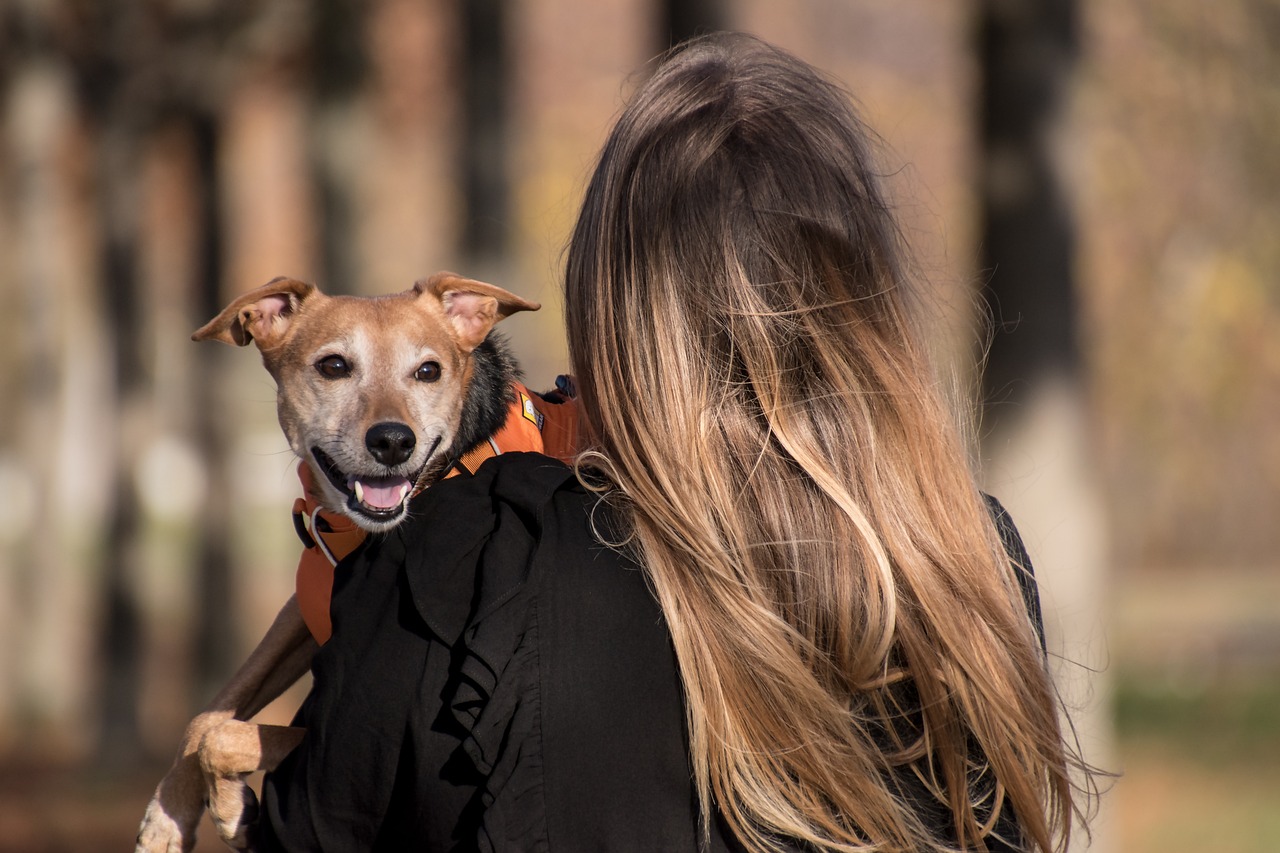
Establishing a Routine
Creating a consistent grooming routine is not just about keeping your pet looking sharp; it's about establishing a trusting relationship and helping them feel comfortable with the process. Imagine how you would feel if you had to undergo a new experience without any preparation—it's daunting, right? By setting a grooming schedule, you provide your furry friend with a sense of predictability that can significantly reduce their anxiety.
Start by determining how often your pet needs grooming based on their breed, coat type, and individual needs. For instance, long-haired breeds may require more frequent grooming to prevent matting, while short-haired breeds might only need a quick brush every couple of weeks. As a general rule of thumb, consider the following:
| Breed Type | Recommended Grooming Frequency |
|---|---|
| Long-haired breeds (e.g., Shih Tzu, Persian) | 2-3 times a week |
| Medium-haired breeds (e.g., Beagle, Cocker Spaniel) | Once a week |
| Short-haired breeds (e.g., Boxer, Dachshund) | Every 2-4 weeks |
Once you've established a frequency, it's essential to stick to it. Consistency is key! Try to schedule grooming sessions at the same time each week or month. This way, your pet will begin to associate that time with grooming, making it less of a surprise and more of a routine. Perhaps you can pair grooming with something they enjoy, like a walk or playtime, to create a positive association.
Incorporating positive reinforcement during grooming sessions is another crucial element of establishing a routine. Treats, praise, and gentle petting can go a long way in making your pet feel more at ease. For instance, every time you finish a grooming session, reward them with their favorite treat or a few minutes of playtime. This not only helps them associate grooming with good things but also strengthens your bond.
Remember, patience is vital. If your pet seems anxious or uncomfortable, take a step back. You can gradually increase the duration of grooming sessions as they become more accustomed to the routine. Breaking the grooming process into shorter, more manageable sessions can help ease them into it. Start with just a few minutes of brushing or clipping, and slowly extend the time as they grow more comfortable.
Lastly, keep an eye on their behavior. If you notice signs of stress or discomfort, it might be time to reassess your approach. Perhaps they need a different tool, or maybe the grooming environment needs to be adjusted. Being attentive to your pet’s needs will help you refine your routine and make it as enjoyable as possible for both of you.
- How long should grooming sessions last? Start with 5-10 minutes and gradually increase as your pet becomes more comfortable.
- What if my pet doesn't like being groomed? Use positive reinforcement and take breaks if they seem stressed. Consider consulting a professional groomer for tips.
- How can I tell if my pet is comfortable during grooming? Look for relaxed body language, such as a wagging tail or a calm demeanor. If they’re tense or trying to escape, it’s time to stop.
Frequency of Grooming Sessions
When it comes to grooming your beloved pet, one of the most important factors to consider is the . This isn't just about keeping your furry friend looking fabulous; it's also about their overall health and well-being. Different breeds and coat types have unique grooming requirements, and understanding these can help you create a personalized grooming schedule that works for both you and your pet.
For instance, long-haired breeds like Yorkshire Terriers or Persian cats typically require more frequent grooming—often several times a week—to prevent mats and tangles. On the other hand, short-haired breeds like Beagles or Boxers might only need grooming once every few weeks. It’s a bit like maintaining a garden; some plants need constant care, while others thrive with minimal attention. If you’re unsure how often to groom your pet, consider their breed, coat type, and any specific needs they may have.
To help you determine the right grooming frequency, here’s a quick reference table:
| Breed Type | Coat Length | Recommended Grooming Frequency |
|---|---|---|
| Yorkshire Terrier | Long | 3-4 times a week |
| Poodle | Curly | Every 4-6 weeks |
| Beagle | Short | Every 4-6 weeks |
| Persian Cat | Long | Daily |
| Boxer | Short | Every 4-6 weeks |
In addition to breed and coat type, consider your pet's lifestyle. If they spend a lot of time outdoors, they may require more frequent grooming to remove dirt, debris, and loose fur. Similarly, if your pet has a tendency to shed heavily, a more regular grooming schedule can help manage the fur situation at home. Think of it as a routine check-up; just like we visit the doctor for our health, regular grooming helps keep your pet’s coat and skin healthy.
Lastly, remember that consistency is key. Establishing a grooming routine not only helps your pet adapt to the process but also reduces anxiety over time. As your pet becomes accustomed to regular grooming, you’ll likely find that they start to enjoy the experience—especially when you incorporate positive reinforcement like treats and praise!
- How often should I groom my dog? - It depends on the breed and coat type. Long-haired breeds often require more frequent grooming than short-haired ones.
- Can I groom my pet at home? - Absolutely! With the right tools and techniques, you can groom your pet at home. Just make sure to educate yourself on the specific needs of your pet's breed.
- What if my pet doesn’t like grooming? - Start with short sessions and gradually increase the time as your pet becomes more comfortable. Use treats and praise to create a positive association.
Incorporating Positive Reinforcement
When it comes to grooming your pet, incorporating positive reinforcement can make all the difference in the world. Imagine this: you're trying something new, and instead of feeling anxious, you get a treat every time you do it right. Sounds great, right? That's exactly how your furry friend feels! By rewarding them with treats, praise, or even a favorite toy during grooming sessions, you can create a positive association with the experience. This not only alleviates their anxiety but also encourages them to be more cooperative.
Consider setting up a simple reward system during grooming. For example, every time you successfully brush a section of your pet’s coat, offer them a small treat or a lot of enthusiastic praise. This can help them understand that grooming is not something to fear but rather an opportunity for bonding and fun. It's all about making grooming feel like a rewarding experience rather than a chore.
To effectively implement positive reinforcement, here are a few tips:
- Start Slow: Introduce new tools or techniques gradually. If your pet is particularly anxious about clippers, begin by letting them sniff and explore the clippers while rewarding them for calm behavior.
- Be Consistent: Use the same cues and rewards each time. This consistency helps your pet learn what to expect and reinforces positive behavior.
- Timing is Key: Give treats or praise immediately after your pet exhibits the desired behavior. This helps them connect the dots between good behavior and rewards.
Moreover, don't forget to celebrate small victories. If your pet allows you to brush them for just a few minutes without fussing, that’s a win! Celebrate it! Over time, these small steps will build up to a much more positive grooming experience. You’ll find that your pet becomes more relaxed and accepting of grooming as they start to associate it with treats, love, and fun.
As you progress, you might even notice your pet looking forward to grooming sessions, eagerly anticipating the treats and praise that come along with it. This creates a win-win situation where both you and your pet can enjoy the grooming process. So, grab those treats, shower your pet with love, and watch as your grooming sessions transform into a delightful bonding experience!
Q1: How often should I reward my pet during grooming?
A1: It's best to reward your pet frequently, especially when introducing new techniques or tools. Consistent rewards help reinforce positive behavior.
Q2: What types of treats work best for positive reinforcement?
A2: Soft, small treats are ideal as they can be given quickly and easily without interrupting the grooming process. Ensure the treats are healthy and suitable for your pet's diet.
Q3: Can I use toys as a reward?
A3: Absolutely! If your pet loves a particular toy, using it as a reward can be very effective. Just make sure to introduce it during grooming sessions to create a positive association.
Q4: My pet seems scared of grooming tools. What should I do?
A4: Start by letting your pet get used to the tools without using them. Allow them to sniff and explore the tools while rewarding calm behavior. Gradually introduce the tools during grooming sessions.
Frequently Asked Questions
- How can I tell if my pet is comfortable with grooming?
Pay attention to your pet's body language! Signs of comfort include relaxed ears, a wagging tail, and a calm demeanor. If they seem tense, try to identify what's bothering them and adjust your approach.
- What grooming tools should I use for my pet?
The right tools depend on your pet's coat type. For example, slicker brushes work well for long-haired pets, while bristle brushes are better for short-haired ones. Always choose tools that are designed for your pet's specific grooming needs!
- How often should I groom my pet?
It varies by breed and coat type! Generally, long-haired pets may need grooming every few days, while short-haired pets might only need it weekly. Establish a routine that works for both you and your furry friend.
- Can I use human grooming tools on my pet?
It's best to avoid human tools as they can be too harsh or ineffective for pets. Invest in grooming tools specifically designed for animals to ensure their safety and comfort during grooming sessions.
- What if my pet is afraid of clippers?
Introduce clippers gradually! Let your pet sniff and explore the clippers before using them. Start with short sessions and provide plenty of treats and praise to create positive associations.
- How can I make grooming a positive experience for my pet?
Incorporate positive reinforcement! Use treats, praise, and gentle petting during grooming sessions to help your pet associate grooming with good feelings. This will make them more willing to accept new techniques.
- What should I do if my pet becomes anxious during grooming?
If your pet shows signs of anxiety, take a break! Allow them to relax and come back to grooming when they're calmer. You might also consider playing soothing music or using calming sprays designed for pets.
- Are there grooming techniques that can help reduce my pet's stress?
Absolutely! Try using slow, gentle movements, and always start with areas your pet is comfortable with. Gradually introduce new techniques and keep sessions short to prevent overwhelming them.


